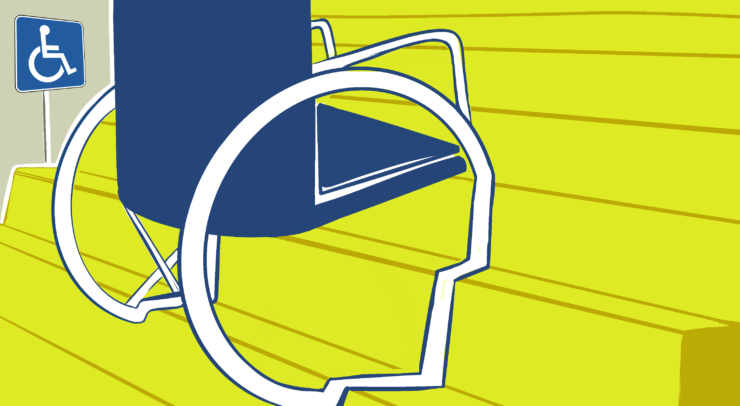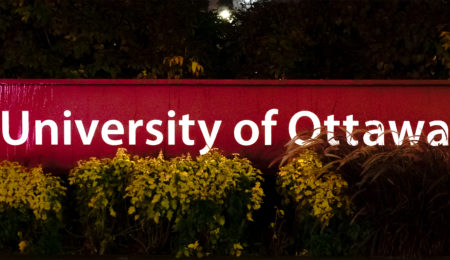Disabled? Don’t Be!
After studying for five years at the University of Ottawa as a disabled student, I think it fair to say that it isn’t the pillar of accessibility. Yes, most buildings on campus have at least one wheelchair-friendly entrance, and the U of O’s Student Academic Success Service (or “SASS”) promises to meet a variety of needs a student with disabilities might require to finish their degrees…
On paper. Or well, in PDFs, really.
But those needs better not include note-taking, hybrid learning, or elevators – all of which, I think, require much more tactful reporting than what I am about to offer.
And so, in simple spite and celebration of my favourite Fine Arts building (100 Laurier) getting the last of its year-long stone makeover, let’s go over a sample of the (un)accessible oopsies the U of O main campus has to offer.
100 Laurier
Home of painters, potheads, and missionary ghosts, 100 Laurier (LRR) has all of the charm of a Gothic Revival castle paired with polished linoleum flooring. Given that it precedes the University’s Building Code, it’s unsurprising that barrier-free paths are non-existent.
Heavy doors welcome visitors. Two sets of three flights of stairs traverse the building, once on the main floor. The main one has ample space for a stairlift, though its addition might detract from the aesthetics of warbled flooring and loose tiles. And really, who would ever want to improve the interior of the building when its exterior rocks are in dire need of polishing?
Anyways!
LRR’s bathrooms in the basement and on the second floor are gender-inclusive, cool. That being said, none of them are wide enough to accommodate a wheelchair user, let alone larger bodies. Plus, for the basement ones at least, there are staircases barring their use, if somehow a wheelchair user could make it down two flights of stairs or over a step at the ground level entrance.
Current or future disabled students hoping to study Fine Arts are forced to either contend with the discriminating infrastructure or study elsewhere entirely.
Pérez Hall
Of all of the Fine or Performing Arts buildings, the department of music’s is the only one with an elevator. A big win when it’s functional.
Pérez is also the only one of the Arts buildings to be connected to the passerelles system; a long stretch of indoor walkways connecting Pérez to Morriset, to Jock-Turcot… all the way to Vanier. And, since Pérez’s (occasionally) working elevator does lead to the passerelles on the third floor, folks with mobility limitations can follow along a winter-proof, barrier-free trajectory.
That is, only if they can get to it. Admittedly, Pérez does have power-operated doors right off of University Private. Its other Cumberland entrance, though, does not. Two doors lead to a rounded hallway where there’s the Freiman Hall for performances on one side, and washrooms on the other.
The lovely, universal sign for accessible stalls is pasted on the two gendered doors. Funny thing is, I couldn’t find a button to open any of the washroom entrances.
And this quirky little washroom sign incongruence isn’t only reserved to Pérez. Even some of the more contemporary additions to the main campus seem to struggle with recognizing accessible bathrooms as a basic need. Cute!
STEM Complex
Unsurprisingly though, the science and engineering building has no toilet troubles. Disabled students and staff have access to ADA-compliant universal rooms, as well as braille-marked multi-stalls on every floor.
Beyond just having an overall light-inviting design, the STEM Complex is also almost entirely barrier-free. A large sinuous platform leads to the power-operated main entrance. Generous hallways surround laboratories and offices. Two elevators allow for 6-storey travel. It’s perfect.
Almost.
As I was making my way throughout the building, I stumbled upon an underground tunnel leading to Marion Hall. Curious, I pressed on the button to see a) if it worked, and b) if it was as wheelchair accessible as the blue sign seemed to suggest.
Imagine my surprise when, at the very end of the tunnel, I was met with a regular, crash bar door. The best part was that, once on the other side, a cute little panel informed me of the mobility-friendly access point down the hall. Right over there. Behind the second pair of doors.
Marion Hall
As my first official introduction to Marion Hall, the tunnel gave me little hope in terms of accessibility. Still, I walked through the basement until I reached my destination: the promised elevator. None of its buttons lit up when pressed. It did, however, finally rattle and creak its way up to the first floor once I closed the elevator.
Aside from the wonky ride, Marion Hall does also have a stairlift that leads to Auditorium 150 on the ground floor. The hallways surrounding the classroom, however, could prove to be cumbersome given their width. But hey, at least there’s a ramp to get through the building, so who’s really complaining?
Desmarais Building
Finally, who could forget the U of O’s cinderblock poster child: the Desmarais Building (DMR). Home to the Telfer School of Management, the Faculty of Social Science, as well as our friends at SASS, the DMR is an impressive 12-storeys of glass and concrete. Coincidentally, the campus’ pride and joy was also the inspiration for this piece.
Weeks ago, as I was heading to my 8:30 am class, the marriage of early morning exhaust and disability-induced fatigue urged me to test the ADA power plate. To my surprise, the door didn’t budge. I tried it again another day, to no avail.
Since then, I’ve had to enter by the Mackenzie King bridge entrance. Note that the doors open slowly. Slower, when the wind pushes them back. But hey, at least there’s a button.
The same can’t be said for washroom entrances above the third floor. Much like the ones in Pérez, some DMR facilities include and promise an accessible stall within the room (by way of having that trusty symbol), but have no nearby activator to even get through the first door.
This sort of design flaw is somewhat forgivable when it comes to older buildings on campus, but to have inaccessible washrooms in one built in 2007 by an “award-winning architectural firm” is beyond insulting.
Final Thoughts
As a disabled student with fibromyalgia, I don’t need accessible entrances and stuff all the time. I can run (sometimes), walk a few flights, and hold doors for the pals (again, sometimes). And I’ll only really find out if I shouldn’t have the next day. But some people desperately need the aid at all times. Some folks have classes on Desmarais’ 9th floor and can’t just “hold it in” because some guy forgot to add a few wires to doors.
Students with disabilities deserve to be able to move around campus and to attend the classes of their choosing — especially in a society that consistently demands higher education.
If the University of Ottawa truly does believe in the core values it promotes on its website, then it should “strive to deliver the best experience to every student” regardless of physical or psychological ability. And, surprise surprise, it isn’t doing great. But, who knows, maybe accessibility will be “in” next year? Fingers crossed.









